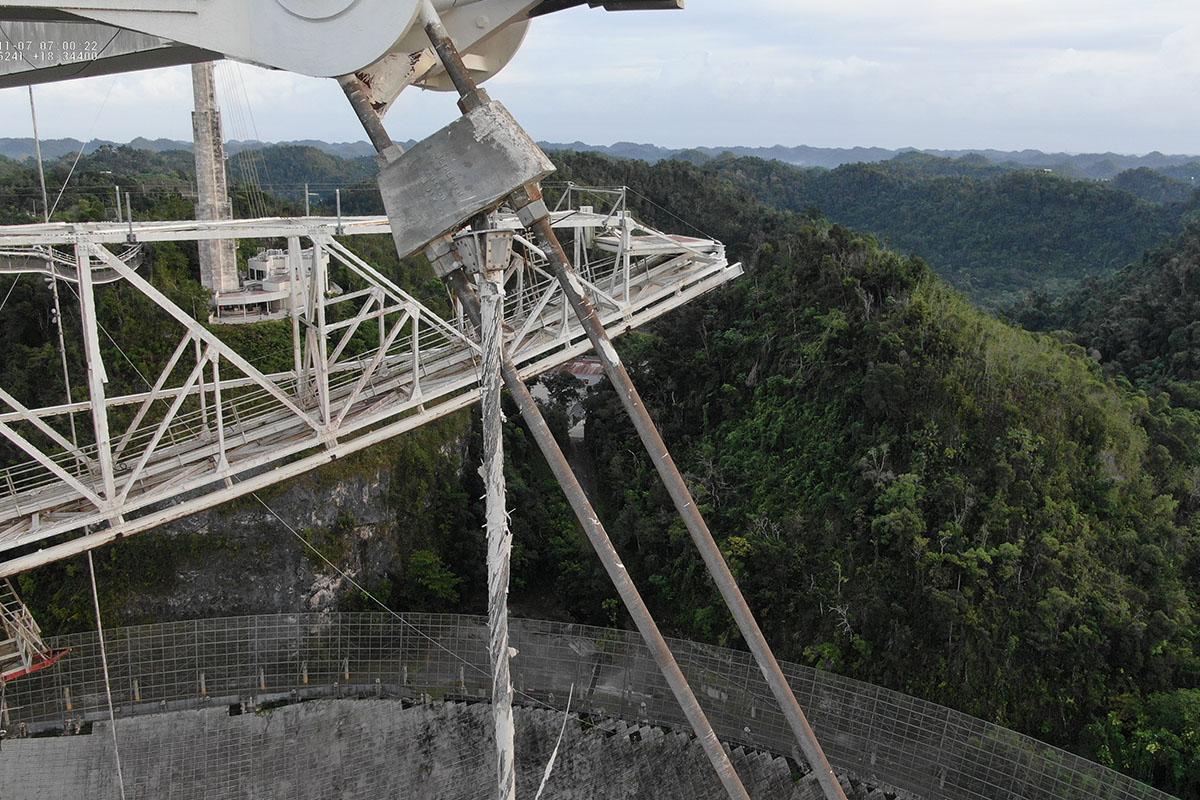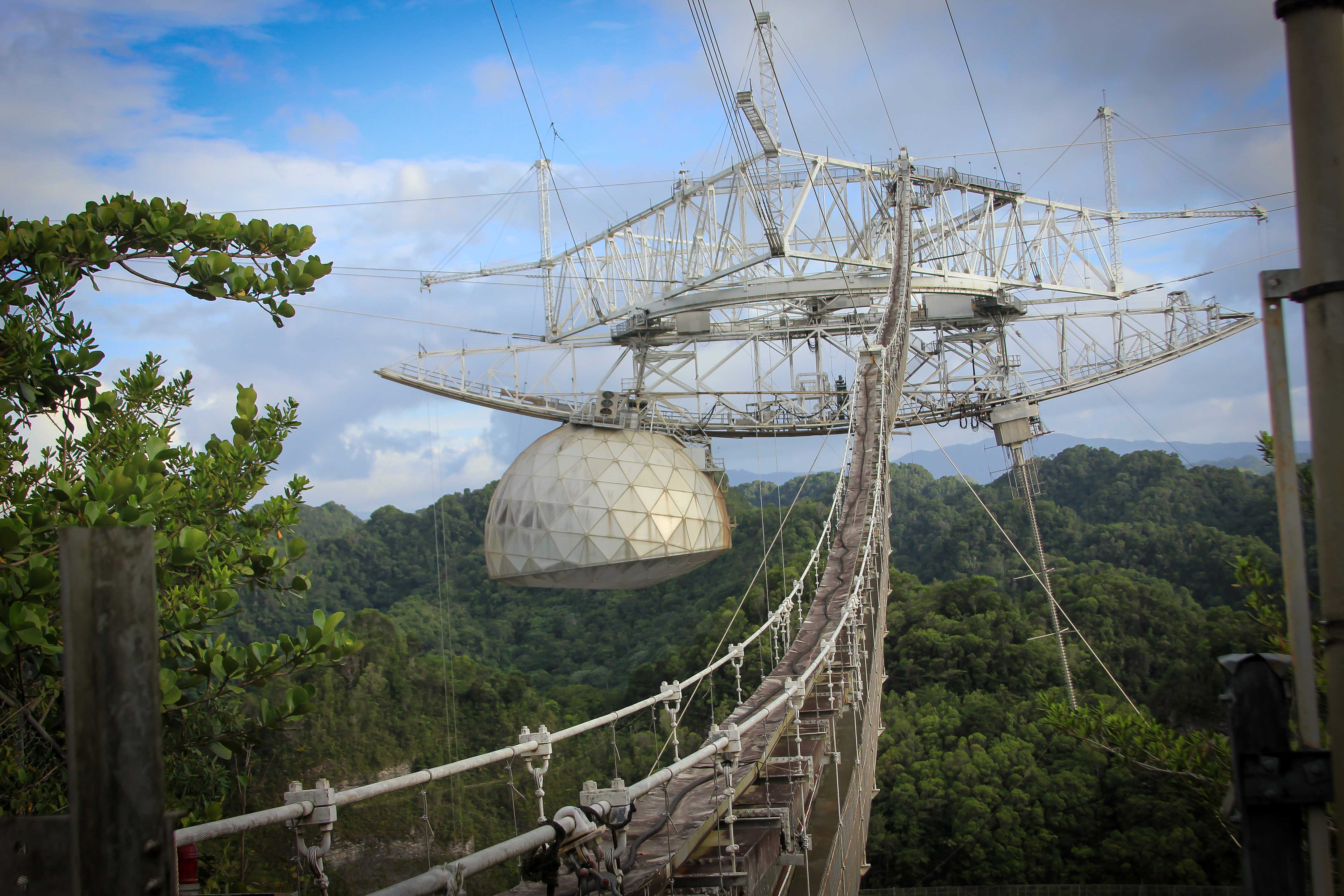Congress asks for report on Arecibo radio telescope collapse
The observatory is not closing, according to the National Science Foundation.

Congress wants a report investigating the December collapse of the iconic radio telescope at Arecibo Observatory by late February as the government evaluates what comes next for the facility, located in the mountains of Puerto Rico.
The request comes as the observatory's supporters continue to rally on the facility's behalf, including a successful public petition calling for White House support of rebuilding at the site and a decision by the island's governor to allocate $8 million to the effort.
Arecibo Observatory's 1,000-foot-diameter (305 meters) radio telescope suffered its most recent structural damage on the morning of Dec. 1, when its 900-ton suspended instrument platform came hurtling down onto the dish itself.
Related: Losing Arecibo Observatory would create a hole that can't be filled, scientists say
The facility has left a 57-year legacy of scientific discovery, in addition to being a mainstay of tourism and education for Puerto Ricans. But the radio dish has been vulnerable for years. In 2017, the National Science Foundation (NSF), which owns Arecibo, evaluated shutting down the radio telescope, then developed partnerships to cover Arecibo's operating costs instead.
But last year was unrelenting for the observatory. In August, a cable that supported the platform slipped out of its socket. And on Nov. 6, just as engineers were preparing to begin repair work, a second supporting cable broke. About two weeks later, on Nov. 19, NSF announced its decision to decommission the radio dish, deeming the platform too dangerous to repair.
Just 12 days later, the platform crashed down.
Get the Space.com Newsletter
Breaking space news, the latest updates on rocket launches, skywatching events and more!
Determining the radio telescope's future
In the aftermath of the collapse, people want to know precisely what happened to the radio telescope — and how the federal government intends to move forward with science at Arecibo.
Puerto Rican students and other activists have focused on formal petitions to the White House. The White House promises to respond within 60 days to petitions that garner 100,000 signatures within 30 days, a threshold that "Rebuild the Arecibo Observatory" has cleared. (A former campaign called "Save the Arecibo Observatory," relaunched after the Dec. 1 catastrophe).
The petition asks Congress "to allocate funding to build a new Arecibo radio telescope with greater capabilities than the previous telescope."

Whether Congress will take up the suggestion remains to be seen, but Arecibo did appear in the fiscal year 2021 Consolidated Appropriations Act, released by Congress on Dec. 21, which includes the Commerce-Justice-Science (CJS) appropriations bill that funds the NSF. The act instructs the NSF to update Congress about Arecibo Observatory within 60 days.
"NSF is directed to report … on the causes and extent of the damage, the plan to remove debris in a safe and environmentally sound way, the preservation of the associated AO [Arecibo Observatory] facilities and surrounding areas, and the process for determining whether to establish comparable technology at the site, along with any associated cost estimates," the act states.
An NSF spokesperson told Space.com that the agency had spent about $5 million on Arecibo's engineering evaluation and stabilization efforts between the August cable failure and shortly after the collapse. However, "engineers and environmental experts are still conducting assessments of the site" and the foundation has not yet determined a cost estimate nor timeline to address the damage and clear debris, NSF representative Robert Margetta told Space.com in an email.
What comes next for the site will take even longer to determine. Unrelated to the NSF, on Dec. 28, Puerto Rico Governor Wanda Vázquez ordered that $8 million go toward reconstructing Arecibo. But such a small sum couldn't build a new radio telescope by itself.
The territory's budgetary decision would likely need to be augmented by federal funding, which would presumably be tied to the NSF's oversight of ground-based observatories. NSF needs more time to make a decision on what to do with the site, the agency emphasized.

"NSF's process for funding and constructing large-scale infrastructure, including telescopes, is a well-established, multi-year procedure that involves assessing the needs of the scientific community, receiving input from researchers and other stakeholders, considering environmental and cultural impacts, and working with Congress," agency representatives told Space.com in an email about the act.
"As the Arecibo Observatory's 305-meter telescope only recently collapsed, NSF cannot comment on any potential future plans at this time," the statement continued. "However, we will continue to work with Congress on the issue, including complying with language accompanying the new omnibus spending package."
The observatory is not closing, the NSF has emphasized. Research using archived data from the massive radio dish telescope, for example, will continue. NSF said it is also looking for ways to restore operations with the observatory's other instruments as soon as possible, including the 12-meter telescope and LIDAR atmospheric-sensing facilities.
"NSF will continue the work of clearing and securing the site of the 305-meter telescope and looks forward to working with Puerto Rico to find new ways to support the scientific community and the local community," the agency added.
Follow Doris Elin Urrutia on Twitter @salazar_elin. Follow us on Twitter @Spacedotcom and on Facebook.
Join our Space Forums to keep talking space on the latest missions, night sky and more! And if you have a news tip, correction or comment, let us know at: community@space.com.

Doris is a science journalist and Space.com contributor. She received a B.A. in Sociology and Communications at Fordham University in New York City. Her first work was published in collaboration with London Mining Network, where her love of science writing was born. Her passion for astronomy started as a kid when she helped her sister build a model solar system in the Bronx. She got her first shot at astronomy writing as a Space.com editorial intern and continues to write about all things cosmic for the website. Doris has also written about microscopic plant life for Scientific American’s website and about whale calls for their print magazine. She has also written about ancient humans for Inverse, with stories ranging from how to recreate Pompeii’s cuisine to how to map the Polynesian expansion through genomics. She currently shares her home with two rabbits. Follow her on twitter at @salazar_elin.









